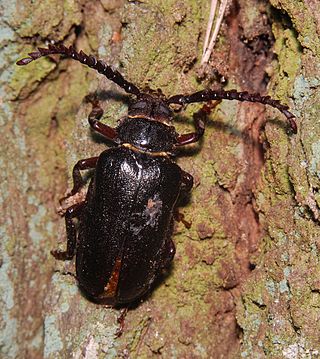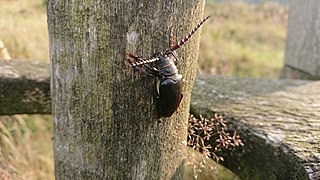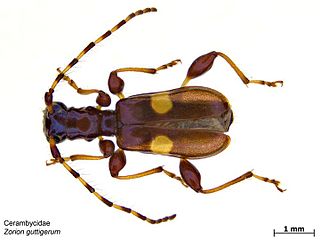
Beetles are insects that form the order Coleoptera, in the superorder Holometabola. Their front pair of wings are hardened into wing-cases, elytra, distinguishing them from most other insects. The Coleoptera, with about 400,000 described species, is the largest of all orders, constituting almost 40% of described insects and 25% of all known animal species; new species are discovered frequently, with estimates suggesting that there are between 0.9 and 2.1 million total species. Found in almost every habitat except the sea and the polar regions, they interact with their ecosystems in several ways: beetles often feed on plants and fungi, break down animal and plant debris, and eat other invertebrates. Some species are serious agricultural pests, such as the Colorado potato beetle, while others such as Coccinellidae eat aphids, scale insects, thrips, and other plant-sucking insects that damage crops.

The longhorn beetles (Cerambycidae), also known as long-horned or longicorns, are a large family of beetles, with over 35,000 species described.

The deathwatch beetle is a species of woodboring beetle that sometimes infests the structural timbers of old buildings. The adult beetle is brown and measures on average 7 mm (0.3 in) long. Eggs are laid in dark crevices in old wood inside buildings, trees, and inside tunnels left behind by previous larvae. The larvae bore into the timber, feeding for up to ten years before pupating, and later emerging from the wood as adult beetles. Timber that has been damp and is affected by fungal decay is soft enough for the larvae to chew through. They obtain nourishment by using enzymes present in their gut to digest the cellulose and hemicellulose in the wood.

Prionus coriarius is a species of longhorn beetle.

The Rosalia longicorn or Alpine longhorn beetle, is a large longicorn that is distinguished by its distinctive markings.

The valley elderberry longhorn beetle is a subspecies of longhorn beetle native to the riparian forests of the Central Valley of California from Redding to Bakersfield. It is listed as a federally threatened species; a proposal to delist the insect was withdrawn in 2014.

Clytus arietis, the wasp beetle, is a wasp-mimicking longhorn beetle species in the genus Clytus.

Xanthocryptus novozealandicus, the lemon tree borer parasite, is a wasp in the family Ichneumonidae. It is a native insect of New Zealand. It is also found in Australia and New Guinea. Females hunt for larvae of wood-boring beetles around March, including the lemon tree borer, a native cerambycid that tunnels into citrus trees, grapes and many native species. When a suitable host is found, the female pushes her ovipositor through the wood and injects her eggs into the grub. This has the incidental benefit of helping to control some pests. X. novozealandicus prefers to prey on second year lemon tree borer larvae. This specific parasite prefers to prey on larger second year larvae due to its larger size.

The Banded Alder Borer, Rosalia funebris, is a member of the very diverse family of longhorn beetles.

Stictoleptura rubra, the red-brown longhorn beetle, is a species of beetles belonging to the family Cerambycidae.

Callipogon relictus is a species of longhorn beetle which is mostly found in Korea, but also in China and southern part of Russian Far East. It inhabits mixed and deciduous forests. The population of Callipogon relictus is decreasing due to deforestation and uncontrolled collection, and therefore the species are listed in the Russian Red Book.

Stenurella melanura is a flower longhorn beetle species of the family Cerambycidae, subfamily Lepturinae.

Stenurella bifasciata is a species of beetle in the family Cerambycidae.

Chlorophorus varius, the grape wood borer, is a species of beetle in the family Cerambycidae.

Phoracantha semipunctata, the Australian Eucalyptus longhorn, is a species of beetle in the family Cerambycidae. Native to Australia, it has now spread to many parts of the world, including practically all countries where tree species of Eucalyptus have been introduced. It has been classified as an invasive pest species of Eucalyptus outside Australia.

Polyarthron pectinicorne is a species of beetle in the family Cerambycidae.

Grammoptera ruficornis is a species of beetle in family Cerambycidae.

Prionus laticollis, also known as the broad-necked root borer or broad necked prionus, is a root-boring longhorn beetle described by Dru Drury in 1773. It is widespread throughout eastern North America: its range covers a vast swath from Quebec in the northeast to Arkansas in the southwest.

Oemona hirta, the lemon tree borer, also known as the whistling beetle or the singing beetle, is a longhorn beetle endemic to New Zealand. Its larvae are generalist feeders, boring into the wood of a wide variety of trees, native and introduced. When citrus orchards were first established in New Zealand, this beetle started inflicting serious damage, and so gained the name "lemon tree borer". Four species within the genus Oemona have been identified, suggesting that more species could be found. When disturbed by predators or humans, the adult beetle stridulates creating a "rasp" or "squeak" sound by rubbing its thorax and head together against an area of thin ridges. Māori would eat a liquid called "pia manuka", which was produced by manuka trees when its wood was damaged by the larvae. When Captain Cook first arrived in NZ, his naturalists, Banks and Solander, collected a lemon tree borer in their first collection between 1769 and 1771. This oldest collected specimen can be found in the British Museum. A few years after the first collection, the species would be first described by the Danish naturalist Fabricius in 1775.

Zorion guttigerum, commonly known as the flower long-horn beetle, is an endemic species of beetle in New Zealand. It is found on the flowers of many plant species and feeds on nectar and pollen.




















